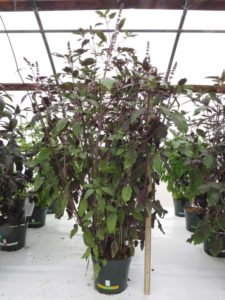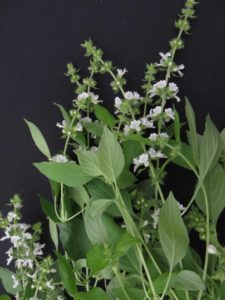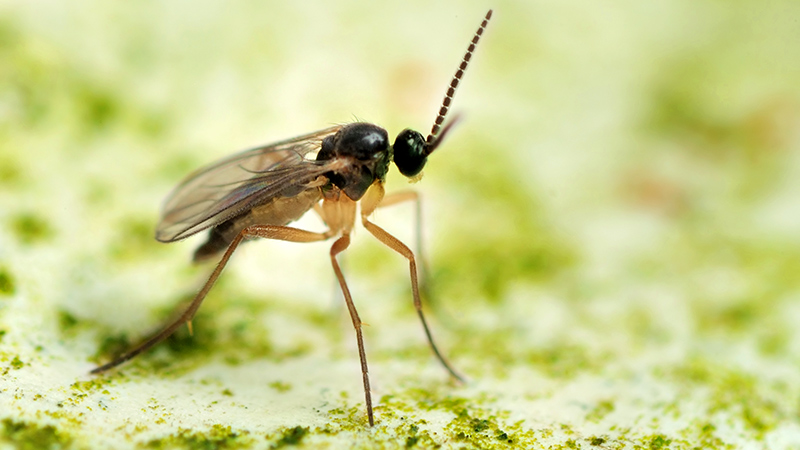Basil : A Cool Twist for a Common Plant

‘Aromatto’ basil has purple stems, purple and green foliage, and pale purple flowers (meter stick for height). Other cultivars with purple flowers include ‘Kapoor Tulsi’ and ‘Sweet Thai’ (purple stems).
Once upon a time, only green basil plants could be found on windowsills and in gardens. Now there is a basil for every need, for every garden, for every customer, any time of the year. Over the past seven years, our research on medicinal crops has focused on basil. Why? Because basil is one of only three annual medicinal herbs — all the rest are biennial or perennial. Basil plants are also day neutral to flower, unlike chamomile and calendula, the other annual herbs. It is also an easy crop to grow, that is if it doesn’t get downy mildew. It can be grown in growth rooms, greenhouses, and yards/fields using just about any growing medium including hydroponics, and basil essential oil retails for $11 per ounce.
Currently, fresh basil is available in some parts of the U.S. year-round. Therefore, this plant also fit our plan to grow it in the greenhouse during the winter. However, the problem with any fresh crop is the imperfect leaves/plants that never make it to consumers. Thus, our research involved discovering an alternative for the basil “seconds,” in this case essential oil. In the process, we grew 20 cultivars in search of the ones that would grow bigger, better, and faster in the greenhouse during the off-season and discovered some additional information we’d like to share.
The cultivars fell into four categories.
- Group 1: Pesto basils (‘Aroma 2’, ‘Dolly’, ‘Genovese’, and ‘Italian Large Leaf’, as well as the disease-resistant ‘Eleonora’, ‘Elidia’, and ‘Nufar’)
- Group 2: Purple leaf basils (‘Amethyst Improved’and ‘Red Rubin’)
- Group 3: Fragrant basils (‘Mrs. Burns’ Lemon, ‘Cinnamon’, ‘Lime’, ‘Spicy Globe’, ’Spicy Bush’, and ‘Sweet Thai’)
- Group 4: Unusual basils (‘Aromatto’- variegated purple and green foliage, ‘Napoletano’- huge lettuce-like leaves, ‘Pluto’ – fine leaf; compact, and ‘Holy’ and ‘Kapoor Tulsi’- used as a tea, for example for stomach ailments).
Our greenhouse set-up needed to be low cost to promote adoption of winter growing. The greenhouse was double-polyethylene air inflated with outside air and heated with forced-air gas via poly tubes under the benches. The benches were covered with capillary mat sandwiches (black poly on the bottom and white/black poly on the top) with holes cut in so the pots could reach the mat. Fertigation was controlled by a time clock for easy control. Plants were grown in large pots (8 inch) in a standard greenhouse mix. They received continual fertilizer of 100 ppm N from 20N-4.4P-16.6K plus varying levels of Osmocote 12N-3.1P-14.9K at planting.

Flowers on basil cultivar ‘Lime.’ Other cultivars with white flowers (with a hint of pink) include ‘Mrs. Burns’ Lemon,’ ‘Spicy Globe,’ and ‘Eleonora.’
The first discovery was that the seeds purchased as ‘Holy’ were not the same as the Indian medicinal plant (according to a couple of our Indian graduate students). Plus, these seeds and that of ‘Kapoor Tulsi’ lagged behind in germination and first true leaves. They also started flowering four weeks after the other varieties. So, buyer beware, if you are looking to use these leaves for medicinal tea.
All other basils grew along the same timeline: that is, three days to germinate; 12 days to first true leaves and 12 to 13 weeks total to flower. Most of the pesto basils smelled either sweet or like anise/licorice. One variety, ‘Spicy Globe,’ which smelled spicy, maintained such a perfect rounded shape that it would be ideal for a garden border. Others like ‘Cinnamon’ had such a strong odor that you didn’t even need to brush the leaves to smell the fragrance. Why not promote planting fragrant, scented basils for areas close to patios and windows as well as in containers on balconies.
The density of glandular trichomes (the source of odors and oils) is greatest on the flowers and this led to a most interesting discovery. The flowers, which are quite pretty, could be marketed for the home gardener as a cut flower herb. That is — a gardener can cut a basil stem in flower, put it in a vase, use the fresh leaves for cooking, and enjoy the scent. These cut stems can last for weeks and may even root while in the vase. This approach is a bit different, and it is important that the flowers be just opening when stems are cut. The pruned basil plant will then continue to grow and produce more leaves and flowers.
Basil plants are ready to market within five weeks of sowing. Consumers are always looking for the new, novel, different in gardening. Educating consumers about the fragrance of basil, even the pestos, and the use as a cut flower herb for beauty as well as cooking could add a cool little twist to a common plant.
For additional details on this basil research, please visit Agronomy.unl.edu/medicinal-and-culinary-herbs.









